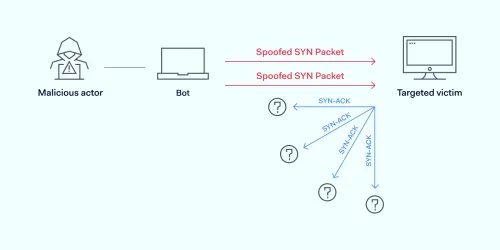
A DDoS attack is when many computers flood a server or network with traffic so it can’t handle real users. This is a big problem for small businesses. People inquire about DDoS attacks. You must know how to safeguard yourself. In early 2025, DDoS attacks rose sharply. Companies like Cloudflare say there were 20.5 million attacks in just the first quarter. That is a 358% increase from the same period last year. Organizations now face more large attacks with record bandwidth.
Websites for small businesses frequently rely on uptime. Your site would go offline when a DDoS attack hits. That means lost sales, frustrated customers, and harm to reputation. Even a short downtime can cost thousands.
The impact is not just money. If people can’t access your site, they may lose trust and go to a competitor. Fixing an attack takes time, effort, and sometimes costs for services or tools.
In this blog, you’ll learn how to detect a DDoS attack early. You’ll also learn practical steps to stop or limit damage. We cover tools, best practices, and affordable protection options so a small business can stay safe while ensuring affordability.
What Is a DDoS Attack?
A DDoS attack is also known as a Distributed Denial of Service attack. It happens when many computers or devices flood a website or server with fake traffic. A DDoS attack does not steal data. It overloads the system to prevent access from authorized users.
Let us take a common example. A small website suddenly gets hit with a huge traffic surge that seems real but is fake. The site may load very slowly, or it may go offline completely. For small businesses, even one hour of downtime can mean lost sales and upset customers.
1. Volumetric Attacks – Overwhelm Bandwidth
These attacks disrupt your internet connectivity with huge amounts of traffic. They use all available bandwidth and prevent real users from getting through.
2. Protocol Attacks – Target Servers and Firewalls
Attacks using protocols target the parts of your network that deal with connections. These attacks send multiple requests and seem normal. However, its focus is mainly on overloading servers, firewalls, or load balancers. The network hardware is slowed down or broken as a result.
3. Application Layer Attacks (Layer 7) – Hardest to Detect
These attacks hit the top layer of your system where websites and apps run. A DDoS attack sends high-volume traffic that looks. And it becomes hard to find that it’s a DDoS attack.
For example, attackers can target your login page. Also, it could be the checkout page or the site’s search functionality.
Why Small Business Sites Are Often Targeted?
Hackers often go after small businesses. The reason is that their security measures are weak. They usually rely on firewalls or basic hosting. On the other hand, big companies have strong DDoS attack protection.
This makes smaller sites easier targets. Additionally, small businesses frequently operate e-commerce or service websites where downtime can quickly hurt sales and reputation.
How to Detect a DDoS Attack Early?
Early detection of a DDoS attack can save you from business losses or downtime. Many business owners often ask the same question: “How do I stop DDoS attacks before they take down my site?”
Well, the first step is to recognize the warning signs. Here are some warning signs that your website might be vulnerable to attacks. Your website begins functioning slowly or stops responding completely. Also, you might be seeing any timeouts or messages.
Are you experiencing any sudden traffic spikes, especially from unknown and fake-like IP addresses or locations? There is probably a chance of a DDoS attack.
Your hosting provider, as well as any component of the DDoS prevention setup, sends you notifications when there are unusual activities or downtime. You see server resource usage exceeding without any increase in legitimate visitors.
How Do I Stop a DDoS Attack: Practical Steps?
You need to act right away upon seeing a DDoS attack. Well, the steps below help in safeguarding small business sites.
1. Contact Your Hosting Provider
Inform them that you think there is a DDoS attack. Many providers offer built-in protections or can raise alerts on your account.
Ask if they can temporarily block suspicious IPs or increase server resources to handle the load.
2. Enable DDoS Attack Protection from Your CDN
Turn on your CDN’s DDoS protection. Cloudflare, for instance, has settings that challenge bots, block flood attacks, and filter traffic. AWS Shield protects sites on AWS from attacks at various layers. Akamai has global edge servers that absorb bad traffic before it reaches your main server.
3. Filter Malicious IPs in Real-Time
Use tools that monitor traffic and block IPs with repeated bad behavior.
Many firewalls or CDN dashboards let you set up geo blocking, block suspicious countries, or block IPs that send too many requests.
4. Use a Web Application Firewall (WAF)
A WAF sits between users and your site. It checks traffic and stops bad requests before they reach your application.
For small businesses, managed WAF services (offered by CDNs or security vendors) are helpful because they update rules automatically and require less maintenance.











